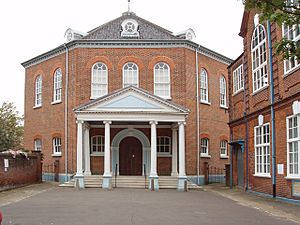Thomas Ivory facts for kids
Thomas Ivory (1709–1779) was an English builder and architect. He was very active in the city of Norwich, where he designed and built many important buildings.
About Thomas Ivory
Thomas Ivory was born in 1709. We don't know much about his early life or how he learned his skills. His first big project was in 1735 at Thrigby Hall, where he worked as a builder and timber merchant. This means he supplied wood and helped construct buildings.
In 1745, he became an official citizen of Norwich. A few years later, in 1751, he was chosen to be the main carpenter for the Great Hospital in the city.
Ivory built a large house for himself near the Great Hospital. He moved into it in 1756. This house is now called St Helen's House.
He went on to design and build several other important places in Norwich:
- The Assembly House (built in 1754).
- A theatre next to the Assembly House (built in 1757, but it's no longer there).
- A Methodist meeting-house on Bishopsgate Street (built 1752–1753).
- The Octagon Chapel on Colegate (built 1754–1756).
- The artillery barracks (built in 1771).
He also built many homes around the city.
Between 1767 and 1779, Thomas Ivory worked with his son, William, and his nephew, John Ivory. Together, they added a new part to Blickling Hall. They designed it to match the old Jacobean style of the house.
Besides building, Ivory also ran a big business importing timber. He had his own timber yard in Bishopsgate. He even managed the Norwich Theatre and had a group of actors called the Norwich Company of Comedians.
Thomas Ivory passed away in Norwich on August 28, 1779. He was buried in Norwich Cathedral. His nephew, John Ivory, made a special monument there to remember him.
Ivory's Family
Thomas Ivory married Hannah Lacey on December 22, 1735. Hannah passed away in 1787.
They had two sons:
- William, who helped his father with architecture. William lived to be 90 years old and died in 1837.
- Thomas, who moved to India and worked there.
They also had a daughter named Sarah.
Key Buildings by Thomas Ivory
Here are some of the important buildings Thomas Ivory worked on:
- His own house in Norwich (1752), now known as St Helen's House.
- Norwich Theatre (1757). This building was later destroyed.
- Methodist meeting-house on Bishopsgate Street, Norwich (1752–1753). It was also known as the "Tabernacle" and was taken down in 1953.
- Assembly House, Norwich (1754). Some parts of the inside might have been designed by James Burrough.
- Octagon Chapel, Colegate, Norwich (1754–1756).
- Houses at 29-35 Surrey Street (1761-1762) and 25-27 Surrey Street (around 1771). The second pair of houses has been demolished.
- Artillery barracks, Norwich (1771). This building is now called Ivory House.
- Additions to Blickling Hall, Norfolk (1767–1779).
- St Catherine's House, All Saints Green, Norwich. His son, William Ivory, might have finished this one.


